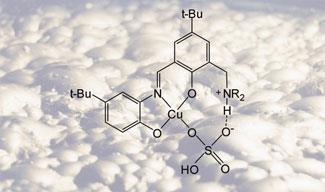Extracting pure copper metal from low-grade metal ores will benefit from the latest coordination chemistry research, thanks to a molecule that can hold negative and positive ions in place, UK chemists claim.
Extracting pure copper metal from low-grade metal ores will benefit from the latest coordination chemistry research, thanks to a molecule that can hold negative and positive ions in place, UK chemists claim.
Peter Tasker’s group at the University of Edinburgh made a specific zwitterionic ligand - a compound with both acidic and basic groups - to take copper sulfate through an entire ionic extraction circuit without generating unwanted sulfuric acid: a crucial breakthrough in extraction technology.

Cationic exchange reagents have been used by metallurgists to generate copper from ore for over 15 years. The process uses sulfuric acid to make copper sulfate, which is purified by a solvent extraction process before electrolysis produces pure copper. Products from each of these steps can feed the others so theoretically the overall process consumes only electricity.
But impure sulfidic ores have always posed problems for this process. Gareth Bates at Southampton University, who has worked with Tasker, explained that sulfidic ores ’can be converted to their oxides but release sulfur dioxide, and are therefore not environmentally sound.’ Also if conventional ligands are used in the purifying process, sulfuric acid can build up in the system.
Since sulfidic ores exist in much greater quantities in the Earth than pure oxides, tapping their copper is the ’holy grail,’ Tasker said. ’It’s possible if your coordination chemistry is very selective.’ His breakthrough is to keep copper sulfate levels steady throughout the extraction cycles, preventing sulfate ions generating extra sulfuric acid. ’That’s not easy,’ Tasker said. ’You’ve got to essentially get copper sulfate soluble in kerosene, and sulfate hates to be in kerosene. you really need to get very special reagents that are able to complex both to copper and to sulfate.’
That special reagent, patented by Tasker’s group, is a diacid ligand that can bind both copper and sulfate ions. Since the sulfate ion also binds to copper, that maintains a complete copper sulfate molecule. ’It’s done exactly what we wanted,’ said Tasker.
Bates agrees: ’It’s a way to extract the pure metal from low-grade sulfidic ores.’ This offers ’possibility of real commercial application,’ he said.
Katharine Sanderson






No comments yet